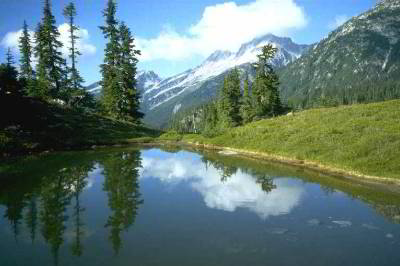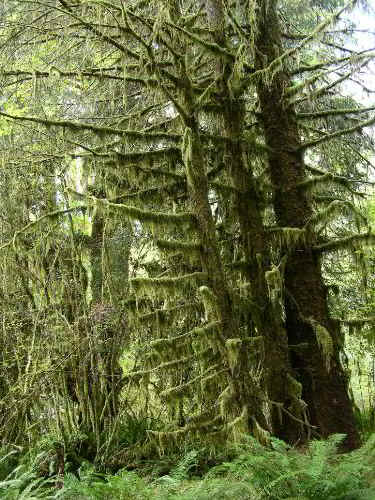Washington
Olympic National Park - photos US National Park Service
 Washington
Washington
On March 14, 2010 the Eastern Native Tree
Society and Western Native Tree Society switched from discussion lists
on Google Groups to a new discussion list in a Bulletin Board format at:
http://www.ents-bbs.org/index.php Posts made since the inception
of the BBS on March 14, 2010 will be sorted and archived on the BBS.
Click on the link to go to the equivalent section on the new BBS. This
website will continue to serve as a front end for the ENTS and WNTS
groups. It will continue to serve as a repository of older posts, and
will serve as the host site for special projects and features that are
not well suited for a BBS format. Please visit the BBS for the latest
information and trip reports.
Field Trips and Discussions
 Olympic National Park
http://www.nps.gov/olym/ Glacier capped mountains, wild Pacific coast and magnificent stands of old-growth forests, including temperate rain forests -- at Olympic National Park, you can find all three. About 95% of the park is designated wilderness, which further protects these diverse and spectacular ecosystems.
Olympic is also known for its biological diversity. Isolated for eons by glacial ice, and later the waters of Puget Sound and the Strait of Juan de
Fuca, the Olympic Peninsula has developed its own distinct array of plants and animals. Eight kinds of plants and 15 kinds of animals are found on the peninsula but no where else on Earth. Olympic National Park
http://www.nps.gov/olym/ Glacier capped mountains, wild Pacific coast and magnificent stands of old-growth forests, including temperate rain forests -- at Olympic National Park, you can find all three. About 95% of the park is designated wilderness, which further protects these diverse and spectacular ecosystems.
Olympic is also known for its biological diversity. Isolated for eons by glacial ice, and later the waters of Puget Sound and the Strait of Juan de
Fuca, the Olympic Peninsula has developed its own distinct array of plants and animals. Eight kinds of plants and 15 kinds of animals are found on the peninsula but no where else on Earth.
 Mount Rainier National
Park http://www.nps.gov/mora/index.htm
Established in 1899. 235,625 acres (97% is
designated Wilderness). Includes Mount Rainier (14,410'), an active
volcano encased in over 35 square miles of snow and ice. The park
contains outstanding examples of old growth forests and subalpine
meadows. Designated a National Historic Landmark District in 1997
as a showcase for the "NPS Rustic" style architecture of the
1920s and 1930s. Mount Rainier National
Park http://www.nps.gov/mora/index.htm
Established in 1899. 235,625 acres (97% is
designated Wilderness). Includes Mount Rainier (14,410'), an active
volcano encased in over 35 square miles of snow and ice. The park
contains outstanding examples of old growth forests and subalpine
meadows. Designated a National Historic Landmark District in 1997
as a showcase for the "NPS Rustic" style architecture of the
1920s and 1930s.

Small lake in the upper East Fork of
Newhalem Creek, North Cascades National Park - photo by US National Park
Service
 North Cascades National
Park http://www.nps.gov/noca/index.htm
Few fully know the intense and rugged beauty of
the North Cascades – jagged peaks, deep valleys, cascading waterfalls
and over 700 glaciers. North Cascades National Park Service Complex
contains the heart of this mountainous region in three park units which
are all managed as one and include North Cascades National Park, Ross
Lake and Lake Chelan National Recreation Areas. Each area offers
different experiences and contains wilderness. A vast majority of the
park complex, over 93%, is managed as the Stephen T. Mather Wilderness,
which was established by Congress in 1988. The wilderness area was named
in honor of the first director of the National Park Service. North Cascades National
Park http://www.nps.gov/noca/index.htm
Few fully know the intense and rugged beauty of
the North Cascades – jagged peaks, deep valleys, cascading waterfalls
and over 700 glaciers. North Cascades National Park Service Complex
contains the heart of this mountainous region in three park units which
are all managed as one and include North Cascades National Park, Ross
Lake and Lake Chelan National Recreation Areas. Each area offers
different experiences and contains wilderness. A vast majority of the
park complex, over 93%, is managed as the Stephen T. Mather Wilderness,
which was established by Congress in 1988. The wilderness area was named
in honor of the first director of the National Park Service.

Olympic National Park - Photo by Edward Frank
 Olympic National Forest
http://www.fs.fed.us/r6/olympic/
The Olympic National Forest is part of an emerald paradise. The Forest is located on the Olympic Peninsula in the northwest corner of Washington State (the Evergreen State). The Olympic Peninsula is a unique geographic province consisting of five major landscape settings: temperate rain forest, rugged mountain terrain, large lowland lakes, cascading rivers, and saltwater beaches.
Here the flora and fauna provide interest beyond the imagination. Recreational opportunities seem unlimited.
The Olympic Peninsula features over 2,132,300 acres of public Federal lands for visitors to enjoy. Of this area, over 633,600 acres are managed by the Olympic National Forest, which blankets the foothills of the Olympic Mountains and surrounds much of the Olympic National Park. In addition to the Federal land on the peninsula, there are recreation opportunities offered on state, county and private lands as well. Olympic National Forest
http://www.fs.fed.us/r6/olympic/
The Olympic National Forest is part of an emerald paradise. The Forest is located on the Olympic Peninsula in the northwest corner of Washington State (the Evergreen State). The Olympic Peninsula is a unique geographic province consisting of five major landscape settings: temperate rain forest, rugged mountain terrain, large lowland lakes, cascading rivers, and saltwater beaches.
Here the flora and fauna provide interest beyond the imagination. Recreational opportunities seem unlimited.
The Olympic Peninsula features over 2,132,300 acres of public Federal lands for visitors to enjoy. Of this area, over 633,600 acres are managed by the Olympic National Forest, which blankets the foothills of the Olympic Mountains and surrounds much of the Olympic National Park. In addition to the Federal land on the peninsula, there are recreation opportunities offered on state, county and private lands as well.
 Visit
Old Growth.com http://www.visitoldgrowth.com/Amount.htm
How much Old Growth Forest still exists? Sometimes, after reading articles or seeing news stories, one would think there is little or no old growth forest left. The fact is that nearly 3 million acres of Old Growth Forest exists today in Washington State after nearly 150 years of mostly uncontrolled logging. That must indicate that most of the existing Old Growth Forests are located in areas that would be very difficult to log and that is why those areas were not logged in those first uncontrolled 100 years.
What is very interesting is that after those 100 years of uncontrolled logging, approximately 6% of the State of Washington is covered in Old Growth Forest. Visit
Old Growth.com http://www.visitoldgrowth.com/Amount.htm
How much Old Growth Forest still exists? Sometimes, after reading articles or seeing news stories, one would think there is little or no old growth forest left. The fact is that nearly 3 million acres of Old Growth Forest exists today in Washington State after nearly 150 years of mostly uncontrolled logging. That must indicate that most of the existing Old Growth Forests are located in areas that would be very difficult to log and that is why those areas were not logged in those first uncontrolled 100 years.
What is very interesting is that after those 100 years of uncontrolled logging, approximately 6% of the State of Washington is covered in Old Growth Forest.

Mount Baker - Snoqualmie National Forest - photo US Forest
Service
 Mt. Baker – Snoqualmie National Forest http://www.fs.fed.us/r6/mbs/
The Mt. Baker-Snoqualmie National Forest in Washington State extends more than 140 miles along the western slopes of the Cascade Mountains from the Canadian border to the northern boundary of Mt. Rainier National Park. The Forest covers portions of Whatcom, Skagit, Snohomish, King, and Pierce Counties.
Through Congressional legislation, 1964 Wilderness Act as well as the
1984 Washington Wilderness Act, forty two percent (42%) of this National
Forest is legally designated as Wilderness. The eight Wilderness
areas that are in or partially in the Mt. Baker-Snoqualmie are listed
below.
Mt. Baker – Snoqualmie National Forest http://www.fs.fed.us/r6/mbs/
The Mt. Baker-Snoqualmie National Forest in Washington State extends more than 140 miles along the western slopes of the Cascade Mountains from the Canadian border to the northern boundary of Mt. Rainier National Park. The Forest covers portions of Whatcom, Skagit, Snohomish, King, and Pierce Counties.
Through Congressional legislation, 1964 Wilderness Act as well as the
1984 Washington Wilderness Act, forty two percent (42%) of this National
Forest is legally designated as Wilderness. The eight Wilderness
areas that are in or partially in the Mt. Baker-Snoqualmie are listed
below.
 Wenatchee National
Forest http://www.fs.fed.us/r6/wenatchee/
The Wenatchee Forest covers an area approximately 40 miles wide and 140 miles in length, encompassing much of Chelan, Kittitas, and Yakima counties. It stretches from upper Lake Chelan on the north to the Yakama Indian Reservation on the south. The vegetation varies with the elevation, from the sagebrush and pine covered slopes at 2,000 feet, to higher elevation areas with alpine fir and mountain huckleberry, to the crest of the Cascade Mountain range at 8,000 feet and above where vegetation is sparse. Approximately 40 percent of the Wenatchee Forest is designated as Wilderness in seven Wilderness Areas: Lake Chelan-Sawtooth, Glacier Peak, Henry M. Jackson, Alpine Lakes, William O. Douglas, Norse Peak, and Goat Rocks. Here, foot travel is the only method of transportation allowed, and the land is managed in such a way as to preserve its natural, primitive condition. There are no developments or roads in Wilderness.
Wenatchee National
Forest http://www.fs.fed.us/r6/wenatchee/
The Wenatchee Forest covers an area approximately 40 miles wide and 140 miles in length, encompassing much of Chelan, Kittitas, and Yakima counties. It stretches from upper Lake Chelan on the north to the Yakama Indian Reservation on the south. The vegetation varies with the elevation, from the sagebrush and pine covered slopes at 2,000 feet, to higher elevation areas with alpine fir and mountain huckleberry, to the crest of the Cascade Mountain range at 8,000 feet and above where vegetation is sparse. Approximately 40 percent of the Wenatchee Forest is designated as Wilderness in seven Wilderness Areas: Lake Chelan-Sawtooth, Glacier Peak, Henry M. Jackson, Alpine Lakes, William O. Douglas, Norse Peak, and Goat Rocks. Here, foot travel is the only method of transportation allowed, and the land is managed in such a way as to preserve its natural, primitive condition. There are no developments or roads in Wilderness.
 Wenatchee National
Forest Wilderness http://www.fs.fed.us/r6/wenatchee/recreate/wilderns.html Wenatchee National
Forest Wilderness http://www.fs.fed.us/r6/wenatchee/recreate/wilderns.html
 GORP - Washington
Wilderness Areas http://gorp.away.com/gorp/resource/us_wilderness_area/wa.htm
Alpine Lakes, Boulder River, The Brothers, Buckhorn, Clearwater, Colonel Bob, Glacier Peak, Glacier View, Goat Rocks, Henry M. Jackson, Indian Heaven, Lake Chelan-Sawtooth, Mount Adams, Mount Baker, Mount Skokomish, Noisy-Diobsud, Norse Peak, Oregon Islands, GORP - Washington
Wilderness Areas http://gorp.away.com/gorp/resource/us_wilderness_area/wa.htm
Alpine Lakes, Boulder River, The Brothers, Buckhorn, Clearwater, Colonel Bob, Glacier Peak, Glacier View, Goat Rocks, Henry M. Jackson, Indian Heaven, Lake Chelan-Sawtooth, Mount Adams, Mount Baker, Mount Skokomish, Noisy-Diobsud, Norse Peak, Oregon Islands,
Pasayten, Salmo-Priest, San Juan WA, Tatoosh, Mt. Skokomish, Trapper Creek, Washington Islands WA, Wenaha-Tucannon, William O. Douglas, Wonder Mountain.
|









